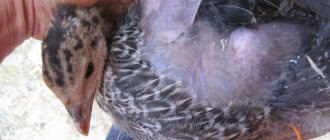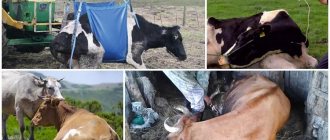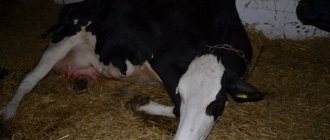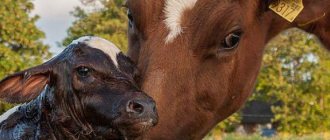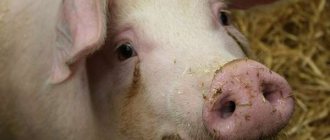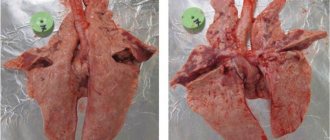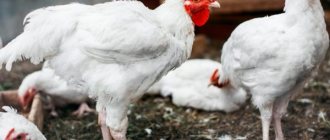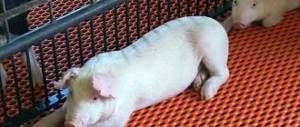Features of the disease
Rumen acidosis is a very common pathology among cattle, which occurs when the rules of animal feeding are not followed. The increase in the number of cases of acidosis is explained by the widespread use of silage-concentrated diets by farmers.
The diet of cattle must include roughage (hay, straw with long-fiber fiber). When using acidic, wet feed, low-quality hay and silage, the pH level in the rumen decreases (to 5.2-5.5), as a result of which milk yield falls, the quality of milk deteriorates, and livestock are prematurely culled.
High levels of butyric acid accumulate in silage when it is dominated by wet or contaminated grass material. Protein breakdown occurs, cows do not receive enough energy, lactic acid predominates in the rumen, and the volume of rumen contents decreases.
Expert opinion
Zarechny Maxim Valerievich
Agronomist with 12 years of experience. Our best country expert.
Ask a Question
Acidosis provokes negative consequences for the cow - disruptions in the mechanism of the proventriculus, a decrease in immune defense, digestive disorders, and suppression of intestinal microflora.
Harmful substances released when bacteria die are transported through the blood to the internal organs, causing inflammatory processes. Due to a sharp decrease in blood glucose levels, fatty liver syndrome and ketosis (the result of the production of glucose from fat stores) can develop. Chronic acidosis causes inflammation of the tissue under the hoof horn - laminitis.
Results of introducing bacterial growth stimulants
As a result of the industrial use of "polis" for several years, many farms in Russia observed an increase in milk production, often accompanied by an increase in fat content, increased feed consumption, significantly increased concentrations of glucose and beta-carotene in the blood, and increased fertility. The main mechanisms of action of the “polis” have been identified.
1. as a result of the introduction of polysaccharides, there is an increase in the microbiological activity of the bacterial flora of the rumen.
The consequence of this is:
- increasing the digestibility of fiber, increasing the rate of fermentation of other feed components,
- since fiber is one of the main limiters of feed intake, an increase in the digestibility of fiber and the rate of fermentation of other feed components leads to an increase in feed intake if the restrictions on feed intake were physically limited, as in the case of the onset of lactation,
- the concentration of volatile fatty acids (VFA) in the rumen increases, the amount of microbiological protein increases and thereby the quality (amino acid composition) of metabolic protein improves,
- with an increase in the rate of bacterial growth, restrictions on growth are removed and bacteria spend energy more efficiently: the proportion of energy spent on maintaining life is reduced and the unproductive dissipation of energy associated with local excess carbohydrates is reduced. as a result, per 1 mole of fermented hexoses, a greater amount of LFA is produced and feed efficiency increases [7],
- higher growth rates of bacterial mass ensure a decrease in the production of toxins with excess carbohydrates.
2. an increase in the microbiological activity of the rumen bacterial flora stimulates the growth of bacteria that utilize lactic acid.
The consequence of this is:
- at least there is no increase in the concentration of lactic acid in the rumen. Since lactic acid is approximately 10 times stronger than acetic, propionic, and butyric acid, it significantly reduces the pH of the rumen, despite its significantly lower concentrations. when polysaccharides are used, there is no active decrease in rumen pH, despite an increase in the concentration of volatile fatty acids (VFA) in the rumen due to a decrease in the concentration of lactic acid,
- reducing or not increasing the concentration of lactic acid in the rumen reduces the risk of developing body acidosis associated with the low metabolic rate of the d-isomer of lactic acid in ruminants.
3. there is a slightly greater increase in the activity of propionate-synthesizing bacteria.
The consequence of this is:
- increased production of propionate and, since propionate is the main source of glucose, blood glucose levels increase. increasing glucose levels is critical immediately after calving and the milking phase.
4. the population of bacterial groups that synthesize beta-carotene in the rumen is activated.
5. as a result of a decrease in the intake of d-isomer of lactic acid and endogenous toxins, the general condition of the cow improves.
The consequence of this is:
- reduction of energy costs to maintain life, which is redistributed to the production of products (milk) or to increase body reserves.
As a result of the work carried out, a technology was developed for producing the regulatory complex “polis” (liquid polysaccharides), which contains “essential” growth factors (oligosugars), polyunsaturated fatty acids, phospholipids, easily digestible carbohydrates, dextrins. At a certain ratio of these components, the growth rate of the rumen microbiota increased and was maintained at a high level, which was confirmed by the effective functioning of ruminal digestion (hiataym system, Israel). Thus, the cow was provided with microbial protein and, most importantly, the growing biomass used the excess glucose catabolites, thereby reducing lipogenesis. The polysaccharide administration regimen was adjusted according to the level of β-carotene in the blood, used as a marker. β-carotene is a “secondary” metabolite and its high concentration in the blood indicates optimal conditions for “secondary” synthesis in combination with the process of growth of rumen biomass.
Another group of “polis” substances are inducers of enzymes that break down non-starchy polysaccharides into short-chain fatty acids with the formation of glycogen in the liver and glucose in the blood. This achieves a high level of glucose in the blood (the upper limit of normal) and, accordingly, insulin. Thus, liquid polysaccharides have a complex effect on the body and effectively prevent metabolic disorders in cows. With the constant use of “polis” in the diet of cows, the culling of animals after calving stops, milk productivity increases by 15-18% during milking and milk retention in subsequent stages of lactation. High levels of insulin and β-carotene help to increase the fertility of cows, reduce the service period, and increase insemination. It is important that the level of milk productivity under conditions of feed and heat stress decreases to a lesser extent. Dosage "polis" 100-150 g/bird per day.
Causes of acidosis in cattle
Ruminal acidosis develops in cattle for the following reasons:
- excess sugar and starch in feed;
- the use of finely ground feed leads to a reduction in the time of chewing food and a decrease in pH levels;
- increased feed moisture causes a decrease in the duration and activity of chewing gum;
- the use of too acidic feeds and concentrates - in particular, silage containing more than 2.5% acids;
- a sharp change in the feed menu - lack of a smooth transition when opening a new trench of haylage and silage (less than 1-1.5 weeks);
- poor quality of feed;
- deficiency of vitamins and minerals - lack of calcium, phosphorus, cobalt, selenium, magnesium, iodine, vitamins A, D, E leads to the death of beneficial microflora and deterioration of food digestion.
See also
The causative agent and symptoms of eimeriosis in cattle, treatment and preventionRead
To avoid the development of acidosis, it is not recommended to quickly transfer cows from a diet of dry animals to a milking menu that includes a large volume of concentrates, or to introduce an excess of sour pulp, stillage, molasses, wheat and barley grains into the menu.
Origin of the disease
The first and largest section of the cow's stomach is the rumen. It can hold up to two hundred liters of feed. The microorganisms existing in it break down fiber and other substances with the help of enzymes. Its location and structure is as follows:
- located in the left side of the abdominal cavity;
- divided into two bags;
- it contains papillae ten centimeters long;
- the presence of longitudinal and circular muscle layers.
More than half of the food received, up to seventy percent, is digested in the rumen. Sometimes metabolic disorders occur in it due to poor-quality cattle nutrition, the transition from roughage to concentrates, lack of necessary vitamins and other reasons.
A decrease in pH levels causes excess lactic acidity. Rumen acidosis in cows leads to weakened immunity due to increased acidity. Cattle cannot digest lactic acid.
- The disease often occurs on farms where there is an excess of concentrated feed and carbohydrates in the feed. If a cow is fed too many apples, grains, beets, or silage at once, acute lactic acidosis will occur. The same reaction can be observed with excess starch - absorption of large volumes of potatoes and molasses. If there is little fiber in the body, this will negatively affect the functioning of the stomach due to the activity of pathogenic microbes.
- Lack of coarse fibers. For example, the weight of a cow is approximately four hundred kilograms. She was given about fifty kilograms of sugar beets at a time. And then two kilograms of carbohydrates were added to the diet every day. She will quickly begin to lose weight.
- If you mix all kinds of waste (pulp, vegetables, stillage and others) and feed it to the cow in a collated form, then in combination with silage this leads to a violation of acidity.
In the first case, the animal's owners did not take into account the moment of restructuring of the rumen microflora under the changed diet. This transition should always be gradual, starting with small volumes. It is very important to follow this rule for cows that know certain nutritional standards.
If cattle have free access to food, then this will be tantamount to death for them.
Dairy cows produce almost two hundred liters of saliva per day. In cattle, chewing cud continues for a total of up to nine hours during the same time. Components of saliva weaken acid reactions, controlling the amount of acid in the rumen. Rough food causes an abundance of saliva. And finely chopped, raw food leads to disruption of the natural secretion of saliva and disturbances in the chewing process. If there is a lack of these components, the food in the rumen will turn sour. As a result, the main symptom will be diarrhea and indigestion.
More on the topic: Symptoms of zuboron in a cow and how to treat it
Main symptoms and forms of pathology
Most often, signs of acidosis develop in cows when farmers improperly prepare animals for calving - a sharp transition to a post-calving diet, an increased content of sugar and starch in feed, and a deficiency of structural fiber.
Acute degree
An acute form of acidosis develops with a rapid and sharp increase in the volume of concentrates in the cows' menu. If animals consume a lot of easily digestible carbohydrates, the level of lactic acid in the rumen increases significantly, and the pH drops below 6. Manifested by severe symptoms:
- prolonged diarrhea;
- risk of developing dehydration;
- necrotization of scar microflora with the risk of internal poisoning.
Acute acidosis is easily diagnosed and treated more quickly.
Subacid (subacute)
The subacute form of acidosis is the most dangerous for cows, since it manifests itself with very weak signs that inattentive farmers may not notice for a long time:
- lethargy;
- increased feeling of thirst;
- covering the tongue with a coating;
- periodic episodes of bloating;
- general body temperature is within normal limits.
As a result of a prolonged course of subacute acidosis, the cow may develop complications such as anorexia, rumen atony, respiratory and heart rhythm disturbances.
Permanent (chronic)
The chronic form of rumen acidosis is manifested by the following symptoms:
- indifferent behavior of the cow, lack of response to stimuli;
- malnutrition of feed or complete refusal of food;
- weakening of rumen motility;
- anemia of mucous membranes;
- bouts of diarrhea;
- reducing the volume of milk produced, reducing fat content;
- low rumen pH.
If therapeutic measures are not taken for a long time, chronic acidosis leads to kidney damage, the formation of an abscess in the liver, laminitis, ruminitis, damage and dystrophy of the heart muscle.
Detection of rumen acidosis
In cows, acidosis can occur even on a farm with a good feed supply. In order to identify this disease, it is necessary to use effective methods and know everything about the causes of its occurrence.
Acidosis
is a disease in which excess lactic acid is formed in the rumen, due to this the pH of the rumen contents shifts to the acidic side (“sour rumen”). Normal rumen acidity is 6.2-6.8. The lower this level, the more severe the disease.
✔Signs of subclinical acidosis
Suspicion of acidosis arises in the presence (separately or simultaneously) of the following factors:
- Daily varying volume of dry matter intake;
- Changing consistency of feces, dirty cow, animals are thirsty;
- Reducing fat content in milk;
- Many cows are emaciated and disheveled;
- Few cows chew the cud (herd observation!) due to insufficient salivation;
- Pica;
- Lack of desire to move, cows lie down a lot and have difficulty getting to their feet, convulsions may occur;
- Grinding of teeth;
- Animals are lethargic, ears drooping;
- During rest - lying down, some cows have their head pressed to their stomach;
- There is an unpleasant sour smell of manure in the room;
- A characteristic feature of acidosis is the massive destruction of animals in a herd that eat the same feed.
Subclinical (not yet clinically manifested!) rumen acidosis is said to exist if the pH of the rumen contents regularly drops below 5.8 or remains at a level of at least 5.8 for a long time.
✔Causes of subclinical acidosis
Previously, the reasons for the increasing frequency of acidosis were seen in too intensive feeding of concentrates and an unbalanced diet. Acidosis can have many causes and occur even with good feed structure. These are the reasons:
- The width of the feeding place per animal is too small - normally 80 cm (with constant availability of feed, 1.5 cows are allowed per feeding place);
- Separate feeding of concentrated feed: at large intervals and more than 2 kg per head per feeding);
- When feeding monofeed, there is insufficient grinding and mixing of feed, resulting in “separation” of feed (selecting smaller and tastier particles of concentrates) by cows;
- Competition for feeding space;
- Overcrowding;
- Rough surface of the feeding table;
- “stingy” feeding – normally 5-10% of the diet should remain on the feeding table after feeding;
- Limited access to food;
- Lack of consistent execution of the order of filling the mixer when using complete mixtures (poor mixing);
- Too little food offered daily and/or supplemented too infrequently;
- Heat stress;
- Problems of hierarchy and dominance within the group;
- Unsuitable body condition;
✔Ways to detect acidosis
1.
To detect acidosis, rumen puncture is most often used in world practice - puncturing it and taking a sample of ruminal fluid. Also, scar contents can be taken through a probe or through a hose (the length of the hose should be slightly longer than the probe - approximately 170 cm) by passing it onto the toothless edge with a Janet syringe. The hose will immediately clog, but 1-2 ml is enough for indicator strips. For a pH meter you need more.
In cows with acidosis, significant fluctuations in the pH of the rumen fluid are observed, so it is very difficult to find the right moment for examination, so it is recommended to take a sample during the period between feedings, when the bulk of the feed has already settled, but has not yet passed further through the gastrointestinal tract.
2.
There is also a method for determining net acid-base excretion in urine. It reflects the compensatory function of the kidneys, urine pH is normally 6.0-6.5. Which try to equalize the content of acids in the blood due to their increased excretion in the urine. But this method is not always indisputable and does not always confirm the presence of acidosis;
3.
A more accurate method is the fractional determination of net acid-base excretion, which involves the determination of not only bases (alkaline elements) and acids, but also ammonia and chloride ions;
✔Consequences of acidosis
- Developing acidosis leads to chronic inflammation of the mucous tissue of the scar (rumenitis). The rumen villi atrophy and toxins enter the bloodstream. Cows experience abdominal pain and are much less likely to chew cud. The consistency of feces changes almost daily. Such cows constantly lose weight, their coat becomes dull and disheveled;
- Simple wounds stop healing (especially on the hind legs), chronic inflammation and swelling of the joints develop;
- Hormonal status also goes wrong. The balance of steroids (precursors to the most important hormones of growth and pregnancy) is seriously disturbed. In acidotic cows, the concentration of progesterone is half that of healthy animals. Consequence: early embryonic mortality, frequent over-walking, difficult calving and retained placenta. In addition, more than half of the “sour” cows have problems with the ovaries (cysts, persistent corpus luteum);
- Due to acidosis, rheumatic inflammation of the hooves often occurs, and as a result, increasing lameness (laminitis). In farms with high levels of chromate, modest fertility rates are also observed.
- The general resistance of the body decreases, the animal’s body practically does not respond to treatment.
Manifestations of subclinical acidosis
